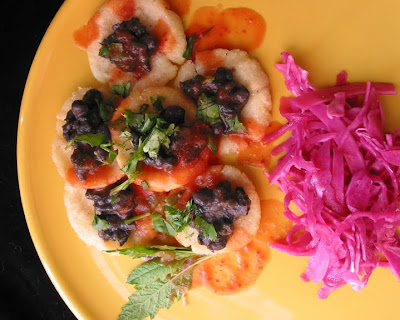
We have sunshine again! Sunny days remind me of vacationing in Tapachula, my mother's home town in Chiapas. In order to beat the heat of preparing food, dinner was not eaten until late. On such warm nights we used to have dinner at an impromptu restaurant set up by some neighboring ladies that people referred to as "Las Juchas". These large and jovial neighbors seemed almost magical to me. They wore beautiful colorful embroidered huipiles, and they wore their family's fortune around their necks, in the form of large chains adorned with gold coins called centenarios. These women were known as "juchas", since they came from town of Juchitan, in Oaxaca. These mysterious ladies have been the inspiration of many artists, among them Tina Modotti, Francisco Zuniga and Diego Rivera. One could say their way of dressing, and their food is a form of art too!
Our neighboring ladies would set up large wooden benches and tables outside their home, right on the side walk. They prepared three simple meals for their guests; fried potatoes and chicken smothered in tomatoes, enchiladas prepared with black Oaxacan mole, and little garnachas. If you were greedy (like me!) you could get a taste of all three. A metal tub full of ice and sodas, mineral water known as Tehuacan, and beers completed the simple meal.
I have no idea why garnachas are not popular in the US. They are delightful little mini corn cakes, one could say they are the predecessors of what came to be known as "nachos" here in the US. Unlike nachos, garnachas are semi chewy, not crispy. They are smaller than a "sope" or a "gordita" and ticker than a tostada. They could be called savory silver dollars - or how about golden savory centenarios? In honor of our Juchitecan friends, I'll give you this vegan garnacha recipe. It creates about 12 garnachas, the recipe can be doubled. You'll need the following ingredients:
One cup of tortilla making corn flour. You can buy Masa Harina or Maseca at MexGrocer.
One cup of vegetable broth
One package of cooked black beans (prepare one day in advance*)
1 bay leaf
1 spring of epazote
1 serrano chile (optional)
2 cloves of garlic
half of a white or yellow onion
Salt and pepper to taste
One cup of vegetable oil for frying
About a cup of tomato gravy similar to the one used for Sopa Seca
Chopped cilantro and chopped onion, to garnish
Optional: Cabbage salad (Prepare at least 3 days ahead of time**)

*Prepare your beans ahead of time. Sort out any impurities, wash and soak overnight. In a large pot, cook the beans in plenty of water. Add more water as the beans cook and the liquid evaporates. Once they are very soft (in about one hour) you can season them with salt, pepper, half the onion, garlic, a bay leaf, epazote spring and a serrano chile. Cook them for about thirty - forty more minutes until most of the broth is absorbed. Mash some of the beans with a potato masher in order to thicken them. Remove the onion remains, the bay leaf and the epazote and let them cool. If you can, try to find fresh epazote. It tastes wonderful with black beans, and it gives Mexican food a characteristic and authentic flavor that can not be replicated with any other herb. To me, a vegan or vegetarian Mexican table can't exist without epazote. In San Francisco I find it at Evergreen Supermarket.

Prepare your masa by adding some warm broth to the corn flour and kneading with your hands. You may add more or less liquid, in order to achieve a nice soft dough. You'll need about one cup of broth for every cup of flour. Make little masa balls about the size of a large grape. Once you have several balls flatten them with the palm of your hand. Poke the garnachas with a fork, this will prevent them from puffing too much. Shallow fry them in vegetable oil on both sides. Continue frying your garnachas in small batches. Drain them in a paper towel.
When you are ready to serve add the black beans as a topping. If you want, you can also smother them in tomato gravy. Garnish with chopped cilantro and onion. Garnachas are generally served with a vinegary coleslaw called "repollo". It is similar to the Central American salad known as "curtido", that is served with pupusas.
**To make the repollo: finely shred a red cabbage and one small red onion. Place it in a jar or a large lidded plastic container with salt, pepper, fresh thyme, a bay leaf and one mashed clove of garlic. Cover with enough white vinegar. Let your cabbage salad marinate for 3 - 5 days. Drain well before serving.



No comments:
Post a Comment